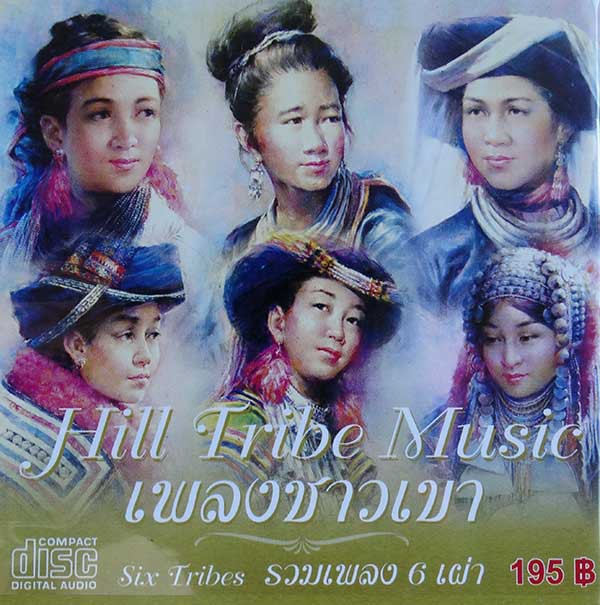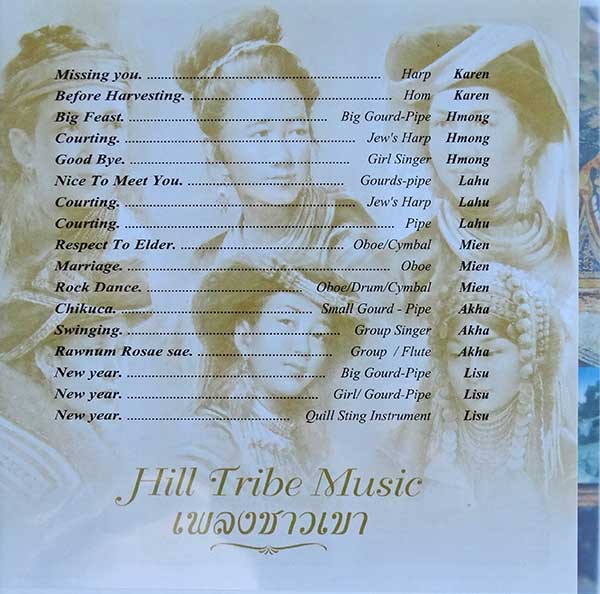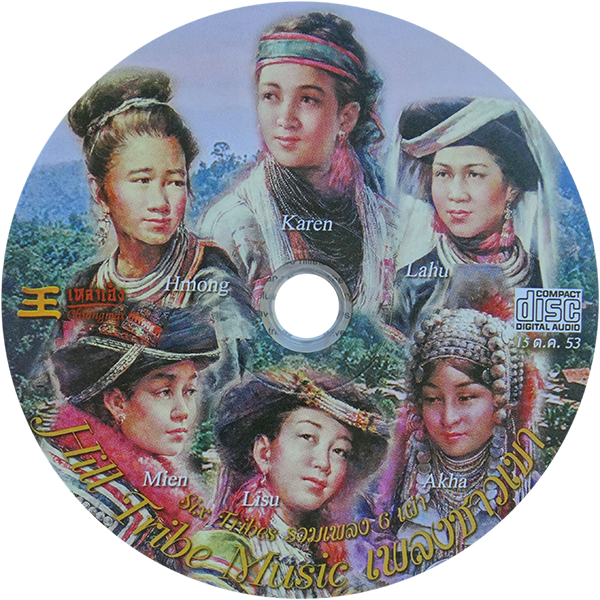





Interesting compilation of fieldrecordings made in Thailand of music of six hilltribes living in and around the Northeast of the country, an area known as The Golden Triangle.
The CD itself doesn't come with any explanation of the tribes, nor who performed or recorded the music and when. Possibly this is a bootleg (pirate copy).
It is likely these recordings are from around 1992, when a series of cassettes on the Disco Cassette label were released in Thailand per tribe group. These cassettes use similar design material like this CD, for instance this cassette with Lisu music.
The tribes represented on this CD are the Karen, Lisu, Hmong, Lahu, Mien & Akha.
They are agrarian and animistic societies in which music takes on a special importance. Most of us think of music merely as a form of recreation and relaxation.
For these tribal societies, music is a heritage of expression through a variety of musical instruments. Music is an extension of speech. Furthermore they are integral part of many vital rituals, ceremonies and festivities of the tribal people.
The Karen originated from the Gobi Desert in Mongolia. They later moved to Tibet, Yunan China and then to Myanmar and north-west Thailand. They have an array of musical sounds and styles expressed through a variety of musical instruments, like buffalo horns. These are used during festivals, courting and for announcing ceremonies.Tthree and four string lutes, one string fiddle and the eight string tube zither are played during courting and festivals. Drums are hung around the waist and played during festivals and weddings. Their eight string arched harp is slung around the shoulders and held to the body like a guitar. Played during courting to the accompaniment of singing, it’s a joy to listen to.
The Lisu are indigenous to Tibet where they still live. Some have migrated to parts of India and western China before moving to Myanmar and Thailand.
The Ahka have their origins in Mongolia before moving to Szechuan and Yunan provinces in China. In the mid 19th century they migrated to the Golden Triangle area. Their music is represented in a variety of wind, string and percussion instruments. Music embodies their tradition, culture and history. Every facet of life is recounted in music, harvest, hunt, phases of life and seasons. Bronze gong and cymbals are used to call spirits during festivals. During courting, soft and melodious bamboo flutes are played.
The Lahu are from the Tibetan Plateau the highest place in the world. Later they migrated to southern China and in recent centuries moved down to Myanmar, Laos, Vietnam and Thailand. Reed pipes, gongs and chants are used by the Lahu to reach gods and spirits. For centuries they have played music to heal, seduce, unite, lament, appease and rejoice. Music is a medium of expression of emotion.
The Mien preserve their history and traditions in song which tells of migration through Central Asia possibly Mongolia before settling south of the Yangtze River 2000 years ago. Their songs tell of the centuries of prosperity.
In the 14th and 15th centuries the Mien migrated to southern China in Hunan, Guangdong, Guangxi, Yunan and Guizhou provinces where many till today. They later moved to North Vietnam, Laos and Thailand.
Their animistic beliefs are blended with Taoism, a result of Chinese influence.
Songs and legends of the Hmong tell of the motherland with icy terrain and harsh winters. Originally from Mongolia, Siberia and Tibet, the Hmong migrated to the Yellow River and settled in lower Yangtze in southern China.
In the 1700s they moved to South East Asia. Their music is an extension of speech, a sacred medium of song, poetry and prayer made all the more melodious by their tonal language.
Musical instruments like mouth harps, flutes, strings and reeds provide a musical extension of their language. Musical instruments take on magical and sacred importance. Music is life.
The minorities are struggling with the effects of modernisation. Their villages are frequently becoming connected to transport routes; new consumer patterns are arising. They are increasingly becoming waged labourers and turning their back on an existence as subsistence farmers. Furthermore, in Myanmar, they are under great threat from the army. And yet, in spite of poverty and suppression, the hill tribes have again and again found strategies to preserve their identity. In this, they stand for many other minorities around the globe who are standing up for their indigenous rights.